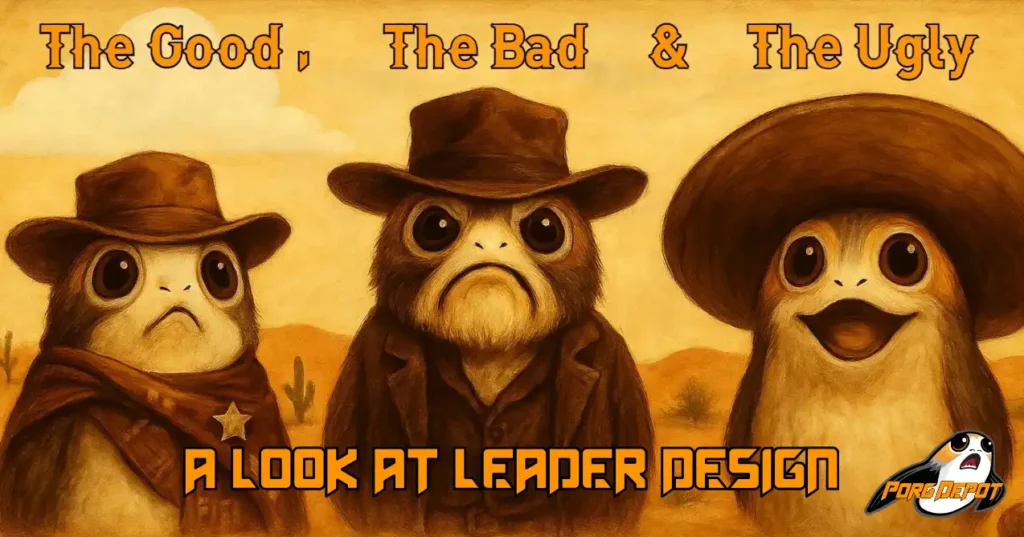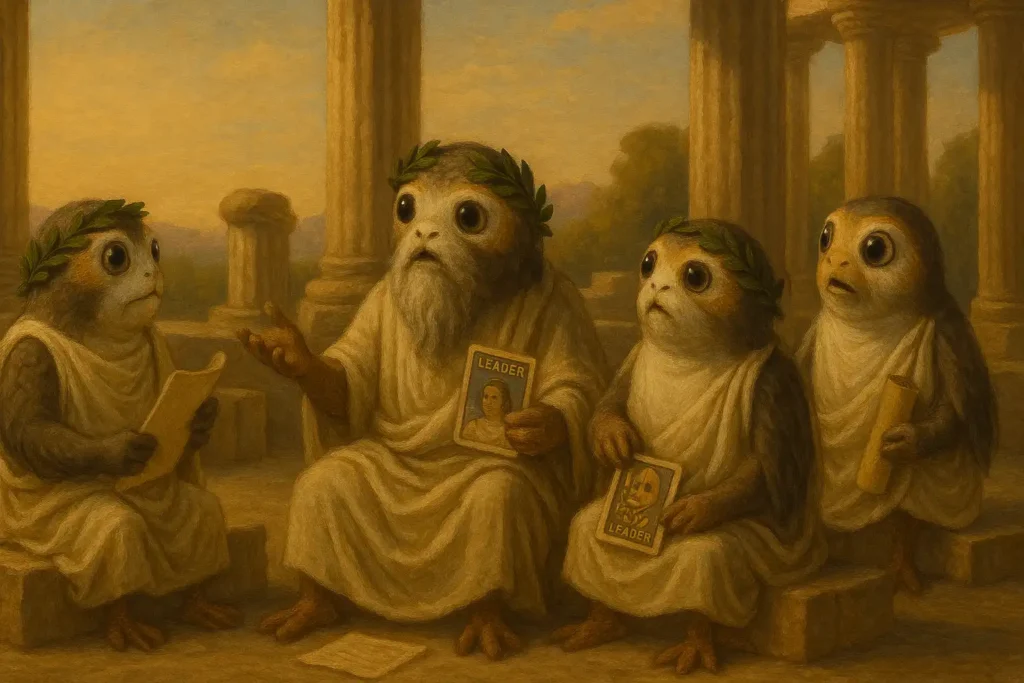The Good, The Bad & The Ugly

“When the storm hits, a leader spreads their wings wide enough to shelter the nest.” — Old Ahch-to Saying
One of the best aspects of Star Wars Unlimited is the freedom to choose our Leader and how that can make a deck take shape and bring the Star Wars universe to life. They are not just random Planes Walkers, whatever those are. They are characters that we know. Personalities that we’ve grown up with. The design and implementation of these cards is perhaps the most important part of the game.
Each set has its own themes laid out by FFG and built upon by various game designers. Looking back on 4 sets now, the community has a pretty good idea of what works for a leader. Deploy cost, stats, abilities on both sides all come into play. We know fairly well what deployment cost and stats make a good leader and no one needs another leader tier list. The thing in particular that we’ll focus on here is how the leader’s ability evolves as it’s deployed and how that design philosophy has changed over time, if at all.

A player should want to have their leader deployed and taking a direct role in combat. They should be powerful and impactful. We’ve seen this pushed a little too far with leaders like SoR Boba Fett and Jango, but it’s better that the boundaries are pushed rather than become stale.
Disclaimer: It should be noted up front that this article is only looking at how the leader ability evolves over the game and not at its general power level. A leader can be excellent in the game but not designed well or vice versa. Besides, “The Good, the Less Good and the Ugly” would have been a terrible title!
Defining the Categories
The Good
Leaders in this category have unit side abilities that directly improve upon deployment or have good continuity with the leader side ability. A generic example would be a leader that deals 1 damage as a leader and 2 damage as a unit. The ability has a clear improvement when flipped.
The Bad
Leaders here have an ability that does not change on deployment. It adds its stats to the board but with either a small or no functional change in its ability. In this case a leader may do 1 damage as a leader and also 1 damage as a unit.
The Ugly
These leaders have abilities that get worse after deployed or lose all synergy between leader and unit. You may prefer to not use the unit side ever because they are more useful as a leader.
Spark of Rebellion
The big theme with Spark of Rebellion is that most of the leaders’ abilities improve when deployed. We can see that FFG made an effort to maintain that design philosophy throughout the set.
The Good. Han adds a resource from your deck instead of hand, Luke shields any unit instead of a newly played hero, Vader deals 2 damage for free instead of 1 resource for 1 conditional damage as some examples of improved leader abilities. Others, Like Emperor Palpatine, have a completely new ability, but perfectly synergizes with the leader’s side. Many leaders in SoR fit into this category.
Total: 14 (Iden, Chewy, Chirrut, Luke, Emperor, Hera, Vader, GI, IG-88, Cassian, Boba Fett, Han Solo, Jyn Erso, Krennix)
The Bad. Leia loses some flexibility when she is deployed since one of the rebels must be her. You are still happy to have her deployed, but she has always struggled to be better than Sabine as a leader. Perhaps this is part of the reason?
Total: 4 (Tarkin, Leia, Sabine, Thrawn)
The Ugly. SoR did such a great job at leader design that there are no leaders that get worse on deploy. Even Jyn and IG-88 are better when they are deployed. They just have other things to worry about.
Total: 0
Shadows of the Galaxy
In this set we start to see some of the designs stray from the philosophy that made Spark so good. Some of these units we’ll see are still good, but there are many more Bad in SHD compared to SoR
The Good. The units that stand out as great design are Cad Bane, who goes from 1 to 2 damage when an Underworld unit is played. Bossk also goes from weakening units with Bounties and then deploys to directly benefit from finishing those units off. That is some great, albeit frustrating, synergy.
Total: 11 (Gar Saxon, Qi’Ra, Jabba, Gideon, Boba Fett, Bossk, Kylo, Bo-Katan, Cad Bane, Mando, Rey)
The Bad. Han Solo, Worth the Risk has the exact same ability front and back. That ability is good enough to be relevant, but there is no functional reason to deploy him other than his 3/6 stats. This also goes for Lando, whose ability is not nearly as relevant, and also provides no benefit on deployment.
Total: 5 (Hondo, Hunter, Han Solo, Fennec, Lando)
The Ugly. Dr. Aphra leader side puts cards from your deck into your discard pile and then on deploy, other than a stat buff and a one-time effect, doesn’t interact with those cards at all. Once she is deployed she loses most of the synergy you spent time building.
Total: 1 (Aphra)
The Finn. Finn could be considered in The Bad section, but he’s also just Finn. He’s so bad that he’s kind of worse than just bad, but also doesn’t fit our current definition for ugly.
Total: 1 (Finn)
Twilight of the Republic
TWI gave us some very powerful leaders as we know all too well. It also gave us a lot of bad and mid-level leaders and not a lot of creativity in the designs.
The Good. Quinlan is a clear upgrade on deployment, allowing him to spread his damage around more liberally. Anakin is another example of excellent design. He allows your units to trade up while also powering up for a future deployment. That’s great synergy.
Total: 9 (Nala Se, Nute Gunray, Obi-Wan, Captain Rex, Maul, Anakin, Asajj, Jango*, Quinlan)
The Bad. A perfect example of a sideways move is Wat Tambor. His leader ability uses an action for +2/+2 and his unit uses an action/attack to give a unit +2/+2. He provides little extra value beyond his stats. SHD also has a lot of leaders that may technically be an improvement but functionally don’t matter. Grievous for example, as a unit he gives a droid an additional +1/+0, which could be considered a sideways move.
Total: 5 (Dooku, Wat Tambor, Padme, Ahsoka, Grevious)
The Ugly. This is where context is important. There are obvious ones like Pre Visla. His leader and unit have nothing to do with each other. His unit side benefits from having cards in your hand but his leader side has nothing to do with cards in hand. Then we have some less obvious ones, like Yoda and Mace. They both have a one-time effect when deployed and then rely completely on stats. After that single effect they have no synergy with any cards in your deck until they are back in the leader spot.
Total: 3 (Yoda, Pre Visla, Mace)
Misc. Chancellor Palpatine is so unique that he is in a category by himself. Power level aside, the design is fantastic and thematic. You have to build your deck to synergize with him.
Total: 1 (Palpatine)
Jump to Lightspeed
We end at the most recent set release, Jump to Lightspeed. This is probably a very polarizing topic and I again urge you to think about it in the context of this article.
The Good. There are 2 standouts in JTL. Piett increases his cost reduction from 1 to 2. Excellent increase in power and it synergizes excellently with your deck. The second one is Luke Skywalker. His leader side can deal 1 damage if you attacked with a fighter, then he turns into an amazing fighter pilot. Again, great synergy before and after deploy.
Total: 6 (Rose, Piett, Phasma, Luke, Poe*, Trench)
The Bad. One leader that had a lot of hype before release was Grand Admiral Thrawn. One of his biggest issues, he doesn’t improve on deploy. His ability is exactly the same so you get no spike in board state when you deploy him other than an extra body.
Total: 6 (Thrawn, Lando, Holdo, Ackbar, Rio Durant, Vonreg)
The Ugly. This is where JTL struggles more than any other set. Many of the pilots have no ability when deployed on the ground and their ability to deploy in space requires you to have a ship. Wedge’s ability is strictly worse even when deployed as a pilot. As a leader he lets you play a pilot, then you can attack with that ship next action. As a pilot you have to attack, then play a pilot, then attack. He goes from needing 2 actions to make use of the pilot to needing 3.
Another controversial one is Boba Fett. His on deploy ability is great, if you have the ship to deploy him on since he can finish off any units weakened from your indirect damage. However, he no longer synergizes with your deck until he’s defeated. There are a lot of similar leaders and we’re seeing them all struggle on the competitive scene. Vader JTL had a decent showing on day 2 at Richmond, but struggled competing against other leaders, possibly because, other than their stats, they don’t offer much, if anything, once deployed.
Total: 6 (Asajj, Vader, Wedge, Boba Fett, Han Solo, Kazuda)
Wrapping Up
| SOR | SHD | TWI | JTL | |
| The Good | 14 | 11 | 9 | 6 |
| The Bad | 4 | 5 | 5 | 6 |
| The Ugly | 0 | 1 | 3 | 6 |
| Misc | 1 | 1 |
Again, this is just an evaluation of how the evolution of a leader’s ability affects the overall power level. The power level of that ability, along with deployment cost and stats play a big part also, but maybe this can help us evaluate leaders in the future by paying attention to their ability and seeing how that has affected things in the past.
One thing we can see is a trend in what FFG is creating. We’re seeing less abilities that evolve over the game and more that are a continuation or regression of the leader ability. Is this a conscious decision or a way for them to manage power level? Time will tell.